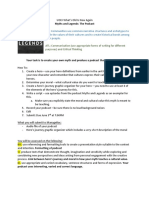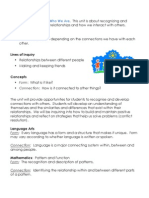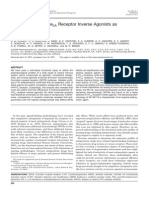English For The IB MYP 4&5:: by Concept
English For The IB MYP 4&5:: by Concept
Uploaded by
Dora MartinezCopyright:
Available Formats
English For The IB MYP 4&5:: by Concept
English For The IB MYP 4&5:: by Concept
Uploaded by
Dora MartinezOriginal Title
Copyright
Available Formats
Share this document
Did you find this document useful?
Is this content inappropriate?
Copyright:
Available Formats
English For The IB MYP 4&5:: by Concept
English For The IB MYP 4&5:: by Concept
Uploaded by
Dora MartinezCopyright:
Available Formats
English for the IB MYP 4&5: by Concept UNIT PLANNER
Teacher(s) Subject group and Language acquisition – English
discipline
Unit title 2 Is my identity my brand? MYP year 4 Unit duration (hrs)
Inquiry: Establishing the purpose of the lesson
Key concept Related concepts Global context
Communication Message Scientific and technical innovation
Statement of inquiry
Messages received through social media and social networking facilitate the communication of identity as a brand and not only shape future forms of self-
expression, but also influence technical innovation.
Inquiry questions
Factual – What is a brand? What is identity? What is a logo? What influences the social web?
Conceptual – How is social networking redefining identity? How do we present ourselves to others via social media? How much is too much information on social
media? What are the benefits of being connected to others via social networks? What are the consequences of conducting so many of our social interactions
online?
Debatable – To what extent does social networking connect us or set us further apart? How are online identity actions different from offline actions?
© Ana de Castro/Hodder & Stoughton Limited 1
English for the IB MYP 4&5: by Concept UNIT PLANNER
Objectives Summative assessment
Outline of summative assessment task(s) including Relationship between summative assessment task(s) and
assessment criteria: statement of inquiry:
The video task allows the students to explore the issues related
CRITERION A: Criterion A: Comprehending spoken and visual text
to the dangers and challenges of posting messages and entering
All strands Rethink before you type – TEDxTeen video – Trisha Prabhu information on social media sites.
Students will view and respond to a TED talk advising them on Students listen to and respond to a talk about social media.
raising awareness about social media sites. Students read, view and respond to a selection of materials
about social trends, image, and the impact it has on behaviour.
CRITERION B: Criterion B: Comprehending written and visual text Students utilize what they have learnt about identity and
All strands branding, choices made and challenges faced. They will justify
What to do about selfies? – Students will read and respond to
their choices based on what they have learnt.
a written article about the phenomenon of the selfie.
© Ana de Castro/Hodder & Stoughton Limited 2
English for the IB MYP 4&5: by Concept UNIT PLANNER
Approaches to Learning (ATL)
Communication skills
Exchanging thoughts, messages and information effectively through interaction
Use a variety of speaking techniques to communicate with a variety of audiences
Use a variety of media to communicate with a range of audiences
Participate in, and contribute to, digital social media networks
Share ideas with multiple audiences using a variety of digital environments and media
Self-management
Affective skills: Managing state of mind (while reflecting on the role of internet and social networks)
Mindfulness: Practise strategies to overcome distractions; practise focus and concentration
Emotional management: Practise strategies to overcome impulsiveness and anger; practise strategies to prevent and eliminate bullying and to
reduce anxiety
Research
Information literacy skills: Finding, interpreting and judging and creating information
Use critical literacy skills to analyse and interpret media communications
Media literacy skills: Interacting with media to use and create ideas and information
Locate, organize, analyse, evaluate, synthesize and ethically use information from a variety of sources and media (including digital social media and
online networks)
Communicate information and ideas effectively to multiple audiences using a variety of media and formats
© Ana de Castro/Hodder & Stoughton Limited 3
English for the IB MYP 4&5: by Concept UNIT PLANNER
Compare, contrast and draw connections among (multi)media resources
Action: Teaching and learning through inquiry
Content Learning process
All students should: Learning experiences and teaching strategies
Express their ideas on the positive and The Learner Profile attribute for the unit is Communicators, and a key ATL focus is media literacy skills.
negative impacts of the social Thus activities as far as possible begin with tasks that help students develop understanding and
media/networks creatively express their ideas through multiple forms, including multimedia.
Identify trends as valuable assets for Activity: SEE–THINK–WONDER (page 26)
research and learning but which can also In pairs, students brainstorm ideas on identity and branding. The task presents an opportunity to
represent dangers in case of misuse, for focus on language.
example addiction to the internet which
DYNAMIC LEARNING Activity: Vishing and smishing: The rise of social engineering fraud
can limit social growth or lead to issues of
identity DYNAMIC LEARNING Activity: ‘Look Up’ by Gary Turk
Having focused on language in the previous activity, this provides an opportunity for students to
Create blogs, podcasts and videos for an
audience use their creativity and language skills.
Activity: Mobile phones and texting (page 37)
Students can use this task to think about personal experience and compare how they relate to
others; identify patterns of behaviour and generate discussion.
DYNAMIC LEARNING Activity: Essena O’Neill quits Instagram claiming social media ‘is not real life’
DYNAMIC LEARNING Interactive activity: Has This Man Unlocked The Secret To Internet
Anonymity?
DYNAMIC LEARNING Interactive activity: Match the words to their synonyms
© Ana de Castro/Hodder & Stoughton Limited 4
English for the IB MYP 4&5: by Concept UNIT PLANNER
DYNAMIC LEARNING Approaches: FLIPPED CLASSROOM Activity: The secret world of teens
To be set as homework. Students can write the essay in class. It presents an opportunity for
assessment of criteria C and D.
FLIPPED CLASSROOM Activity: Present continuous vs Present perfect continuous
Activity: The New Rude (page 46)
Reading comprehension task that focuses on language and ties in with the previous tasks – looking
at what has become acceptable/unacceptable behaviour. Students work with a newspaper article.
The task provides an opportunity for individual reflection.
Activity: Read all about it! (page 48)
Continuing to look at media and headlines linked to social media. Students need to find the original
articles online. Exposure to the amount of cover these issues receive – students can extend the task
by writing their own newspaper style article on one of the areas they are most interested in.
Summative tasks (pages 50–52)
DYNAMIC LEARNING Answers to summative questions
Formative assessment
Criteria C & D: Demonstrates an understanding of different viewpoints about the nature of branding
and gives their own impressions and points of view.
Criteria A & B: Examines trends, ideas and exposure that have influenced their own behaviour and use
of social media.
© Ana de Castro/Hodder & Stoughton Limited 5
English for the IB MYP 4&5: by Concept UNIT PLANNER
Differentiation
Use of pair work and think–pair–share routine allows students to work with each other and develop
each other's understanding.
Provide links from students’ experience to key concepts by using definitions, analogies, attributes,
characteristics and first-hand experience depending on the amount of students’ prior knowledge.
Flipped classroom allows students to complete, process, take notes and prepare questions at their own
pace.
The summative tasks are levelled, providing access to students of varying language capabilities.
Key/access vocabulary is highlighted for English language learners.
© Ana de Castro/Hodder & Stoughton Limited 6
English for the IB MYP 4&5: by Concept UNIT PLANNER
Resources
PowerPoint presentation: DYNAMIC LEARNING Building blocks for Chapter 2
Online resources:
www.bbc.co.uk/news/business-35201188
www.youtube.com/watch?v=Z3o4lnGFQjY
http://garyturk.com/portfolio-item/lookup/
www.theguardian.com/media/2015/nov/03/instagram-star-essena-oneill-quits-2d-life-to-reveal-true-story-behind-images?CMP=share_btn_tw
www.youngwriters.co.uk/types-acrostic
http://f-st.co/jJ4wUWE
www.youtube.com/watch?v=t-9LtTtkg04
© Ana de Castro/Hodder & Stoughton Limited 7
English for the IB MYP 4&5: by Concept UNIT PLANNER
Reflection: Considering the planning, process and impact of the inquiry
Prior to teaching the unit During teaching After teaching the unit
© Ana de Castro/Hodder & Stoughton Limited 8
You might also like
- MYP Poetry Unit PlanDocument12 pagesMYP Poetry Unit PlanAngela Butler100% (1)
- MYP 3 - Unit 1 Plan - MemoirsDocument6 pagesMYP 3 - Unit 1 Plan - Memoirscarolyao100% (2)
- Mulholland DriveDocument30 pagesMulholland DriveDilgrace Kaur50% (2)
- ATL PacketDocument23 pagesATL PacketMarcelaTB100% (1)
- Myp Unit Planner (Health)Document5 pagesMyp Unit Planner (Health)Wan Ruziana SulaimanNo ratings yet
- Myp 5 Design Mock 2022Document6 pagesMyp 5 Design Mock 2022GEORGE MATTHEWNo ratings yet
- MYP Personal Project ReportDocument11 pagesMYP Personal Project ReportAlvin Tse50% (2)
- MYP Unit Planner PhotographyDocument5 pagesMYP Unit Planner PhotographyBibek ShresthaNo ratings yet
- Myp Unit Plan 2Document6 pagesMyp Unit Plan 2api-52484518567% (3)
- Element Checklist For MYP Unit Planners: Does The Unit Include The Following?Document8 pagesElement Checklist For MYP Unit Planners: Does The Unit Include The Following?Shantha KundapuraNo ratings yet
- Myths and Legends Podcast SummativeDocument3 pagesMyths and Legends Podcast Summativeapi-401098405No ratings yet
- CRM TemplateDocument16 pagesCRM TemplateAnna JuliaNo ratings yet
- How Does Goethe Portray Nature in His Poetry?Document3 pagesHow Does Goethe Portray Nature in His Poetry?kyuzo13130% (1)
- Crab MentalityDocument10 pagesCrab MentalityTaylcr Swift0% (1)
- Final Design E-Portfolio Main Criteria A-B-CDocument22 pagesFinal Design E-Portfolio Main Criteria A-B-Capi-540488192No ratings yet
- Unit Title: Inquiry: Establishing The Purpose of The UnitDocument3 pagesUnit Title: Inquiry: Establishing The Purpose of The UnitNina BitskinashviliNo ratings yet
- Personal Project 420 SchoolsDocument40 pagesPersonal Project 420 SchoolsHagori Bawo100% (1)
- IB Language A1Document7 pagesIB Language A1KH WiltNo ratings yet
- IDU Planning @sjtylrDocument1 pageIDU Planning @sjtylrammanappara100% (1)
- ManageBac Global Update-IB Oct 2021Document24 pagesManageBac Global Update-IB Oct 2021Dasha LinNo ratings yet
- Lesson Plan 2 - Art20dDocument4 pagesLesson Plan 2 - Art20dapi-523925517100% (1)
- Pre-Publication: Fostering Interdisciplinary Teaching and Learning in The MYP (Pre-Publication)Document58 pagesPre-Publication: Fostering Interdisciplinary Teaching and Learning in The MYP (Pre-Publication)Pooja MadhuriNo ratings yet
- IDU LL+Sci Y3 EnvironmentalJournalism ManagebacRevised PDFDocument13 pagesIDU LL+Sci Y3 EnvironmentalJournalism ManagebacRevised PDFRima MohamadNo ratings yet
- (MYP5 Design) Designing For Connectedness (EPortfolio) (TSC)Document6 pages(MYP5 Design) Designing For Connectedness (EPortfolio) (TSC)tamararox2008No ratings yet
- Personal Project ReportDocument19 pagesPersonal Project ReportZLoyIzumrudikNo ratings yet
- IB MYP Guide For Students and Parents 2021 ENGDocument79 pagesIB MYP Guide For Students and Parents 2021 ENGdanin danoninoNo ratings yet
- MYP Personal Project JournalDocument5 pagesMYP Personal Project JournalKharthik RamanathanNo ratings yet
- An IB World School: Vgws /myp 3 / Subject - Design /year 2019 - 2020 Page ofDocument6 pagesAn IB World School: Vgws /myp 3 / Subject - Design /year 2019 - 2020 Page ofaditi anandNo ratings yet
- Research Skills For MYP and DPDocument8 pagesResearch Skills For MYP and DPMarcelaTBNo ratings yet
- MYP Unit Planner LogosDocument3 pagesMYP Unit Planner Logosmattjnz9950No ratings yet
- Myp Grasps AssessmentDocument4 pagesMyp Grasps AssessmentRasha Maher100% (1)
- Personal Project GuideDocument37 pagesPersonal Project Guideapi-245643544100% (2)
- (TODDLE) Mapping ATLs For MYP SubjectsDocument11 pages(TODDLE) Mapping ATLs For MYP Subjectswwzsto100% (2)
- Socials - 00 - Ngo Unit PlanDocument4 pagesSocials - 00 - Ngo Unit Planapi-526315392No ratings yet
- IB Middle Years Programme (MYP) Semester One Progress ReportDocument18 pagesIB Middle Years Programme (MYP) Semester One Progress ReportFaisal AlfozanNo ratings yet
- Report MYPDocument13 pagesReport MYPHeryien Salim100% (3)
- MYP Community Project Process JournalDocument16 pagesMYP Community Project Process JournalChristopher Clark100% (2)
- ATL Planning Chart 2Document53 pagesATL Planning Chart 2Ashkan ValiNo ratings yet
- MYP Projects - Personal Project CriteriaDocument5 pagesMYP Projects - Personal Project CriteriaLennoxMeldrumNo ratings yet
- MYP Command TermsDocument3 pagesMYP Command TermsLennoxMeldrumNo ratings yet
- Short Story Unit: Janelle Leegstra English Language Arts Grade 9 September 18 - October 13Document6 pagesShort Story Unit: Janelle Leegstra English Language Arts Grade 9 September 18 - October 13api-282527977No ratings yet
- IBDP Curriculum Handbook 2022Document29 pagesIBDP Curriculum Handbook 2022RAJVEER GHOSH100% (2)
- Individuals & Societies: Hodder & Stoughton © Danielle Farmer, Louise Harrison and Robbie Woodburn 2017Document15 pagesIndividuals & Societies: Hodder & Stoughton © Danielle Farmer, Louise Harrison and Robbie Woodburn 2017student demoNo ratings yet
- Language - and - Literature SGODocument15 pagesLanguage - and - Literature SGOmayaNo ratings yet
- Unit of Inquiry: Who We AreDocument2 pagesUnit of Inquiry: Who We ArebladeneNo ratings yet
- MYP End-of-Unit 1 Students' Reflection (Year 4) 21Document2 pagesMYP End-of-Unit 1 Students' Reflection (Year 4) 21Abdullah Wahashi100% (1)
- Annotated Learning Plan Template ELEMENTARY & SECONDARYDocument3 pagesAnnotated Learning Plan Template ELEMENTARY & SECONDARYJason LabrecqueNo ratings yet
- PQP Peer Feedback FormDocument1 pagePQP Peer Feedback FormmrsnordstromNo ratings yet
- Personal Project First Draft Supervisor Feedback (Escuela Greenfield)Document5 pagesPersonal Project First Draft Supervisor Feedback (Escuela Greenfield)Edw Vergara100% (2)
- Lesson Plan AdvertisementDocument10 pagesLesson Plan Advertisementapi-385152326No ratings yet
- Digital Literacy: Lesson Plan On Social Media Unit OverviewDocument13 pagesDigital Literacy: Lesson Plan On Social Media Unit OverviewEsplana Martinez Mae AngelNo ratings yet
- DLP Mil 1-2Document3 pagesDLP Mil 1-2ShanNo ratings yet
- DLP Mil 1Document4 pagesDLP Mil 1ShanNo ratings yet
- Integrative Performance TaskDocument4 pagesIntegrative Performance TaskPatricia Anne RamelNo ratings yet
- 405 Grade 10 Media Literacy UnitDocument19 pages405 Grade 10 Media Literacy Unitapi-291290415No ratings yet
- DLP Mil 1-3Document3 pagesDLP Mil 1-3ShanNo ratings yet
- Media, Communication and DevelopmentDocument11 pagesMedia, Communication and DevelopmentAdil HossainNo ratings yet
- MYP Unit Planner 102.01Document10 pagesMYP Unit Planner 102.01潘卫平No ratings yet
- DLL New-January (MIL 1wk) - Copy3Document3 pagesDLL New-January (MIL 1wk) - Copy3estrina bailonNo ratings yet
- 1 - Discipline of CommunicationDocument7 pages1 - Discipline of Communicationchewy choco100% (3)
- Humss 12Document7 pagesHumss 12maeggie torresNo ratings yet
- GTB1 PLC14 Module 1 UlaDocument5 pagesGTB1 PLC14 Module 1 Ulayolanda obemioNo ratings yet
- Ten Strategies for Building Community with Technology: A Handbook for Instructional Designers and Program DevelopersFrom EverandTen Strategies for Building Community with Technology: A Handbook for Instructional Designers and Program DevelopersNo ratings yet
- Elearning Theories & Designs: Between Theory & Practice. a Guide for Novice Instructional DesignersFrom EverandElearning Theories & Designs: Between Theory & Practice. a Guide for Novice Instructional DesignersNo ratings yet
- Sociology 100 Introduction To Sociology Winter 2020 Essay AssignmentDocument3 pagesSociology 100 Introduction To Sociology Winter 2020 Essay AssignmentevansNo ratings yet
- ENGLISH+8 Q3 Mod6 Week8 - Parallel+Structures - FINALDocument20 pagesENGLISH+8 Q3 Mod6 Week8 - Parallel+Structures - FINALchristinejoysalvador0919No ratings yet
- (Elphinston, Feeney & Noller, 2011) .Document10 pages(Elphinston, Feeney & Noller, 2011) .Romina Adaos OrregoNo ratings yet
- D.M. Weiner Et Al - 5-Hydroxytryptamine2A Receptor Inverse Agonists As AntipsychoticsDocument9 pagesD.M. Weiner Et Al - 5-Hydroxytryptamine2A Receptor Inverse Agonists As AntipsychoticsCortate15gNo ratings yet
- BSBWOR501 Student Assessment v1.0Document6 pagesBSBWOR501 Student Assessment v1.0Ceclie DelfinoNo ratings yet
- HOMEROOM GUIDANCE (Learning Activity Sheet)Document5 pagesHOMEROOM GUIDANCE (Learning Activity Sheet)Salve SerranoNo ratings yet
- Fenomena Penistaan Agama Dalam Perspektif Islam Dan Filsafat Pancasila (Studi Kasus Terhadap Demo Jilid II Pada 04 November 2016)Document19 pagesFenomena Penistaan Agama Dalam Perspektif Islam Dan Filsafat Pancasila (Studi Kasus Terhadap Demo Jilid II Pada 04 November 2016)Achmad JanjaniNo ratings yet
- Anne Uy (Chapter 1)Document8 pagesAnne Uy (Chapter 1)Lance Patrick EvangelistaNo ratings yet
- Artificial Intelligence (AI) Electronics Engineering (ECE) 4th Year Notes, Books, Ebook PDF DownloadDocument153 pagesArtificial Intelligence (AI) Electronics Engineering (ECE) 4th Year Notes, Books, Ebook PDF DownloadVinnie Singh100% (1)
- The Essential Guide To Professional Learning - CollaborationDocument8 pagesThe Essential Guide To Professional Learning - Collaborationapi-251483947No ratings yet
- Intern ReportDocument30 pagesIntern ReportSuraksha Koirala50% (4)
- Oral TraditionDocument1 pageOral TraditionDaniel HastayNo ratings yet
- Answer Key CM 2022Document1 pageAnswer Key CM 2022Sita KumariNo ratings yet
- The Truth-Seeker's Handbook: A Science-Based GuideDocument53 pagesThe Truth-Seeker's Handbook: A Science-Based GuideJune Lyn100% (1)
- Unit1 ResourcesDocument41 pagesUnit1 ResourcesNadia Abigail DowneyNo ratings yet
- American Values and AssumptionsDocument3 pagesAmerican Values and Assumptionswinda_syafitri0% (2)
- Training and DevelopmentDocument7 pagesTraining and DevelopmentUvasre SundarNo ratings yet
- Project Execution ProblemsDocument10 pagesProject Execution ProblemsAishatu Musa AbbaNo ratings yet
- Super Questions For Everyone PDFDocument123 pagesSuper Questions For Everyone PDFZurab RoysonNo ratings yet
- Lesson Plan 1 Teacher Candidate Name: Amy Hanzlicek Grade & Subject Area: 5 Date For Planned Lesson: February 13, 2017Document14 pagesLesson Plan 1 Teacher Candidate Name: Amy Hanzlicek Grade & Subject Area: 5 Date For Planned Lesson: February 13, 2017api-318777306No ratings yet
- Ra 9344Document24 pagesRa 9344thedoodlbotNo ratings yet
- Cot Rating Consolidation AutomatedDocument12 pagesCot Rating Consolidation AutomatedPinkz Trinidad TalionNo ratings yet
- Syllabus For I and II Semester B.Des. Degree 2019: Apj Abdul Kalam Technological UniversityDocument22 pagesSyllabus For I and II Semester B.Des. Degree 2019: Apj Abdul Kalam Technological UniversitySree LakshmiNo ratings yet
- WT1 SL CriteriaDocument1 pageWT1 SL CriteriaSPAMMMNo ratings yet
- Richards (1990) Design Materials For Listening PDFDocument18 pagesRichards (1990) Design Materials For Listening PDFnenoula100% (1)
- Theri GathaDocument26 pagesTheri GathaLalit MishraNo ratings yet

























































































